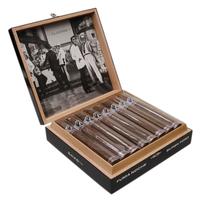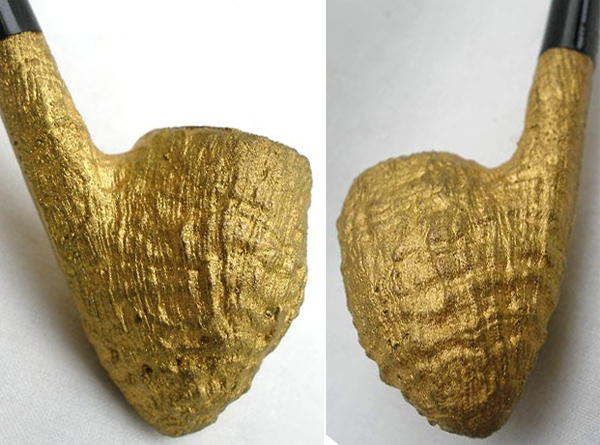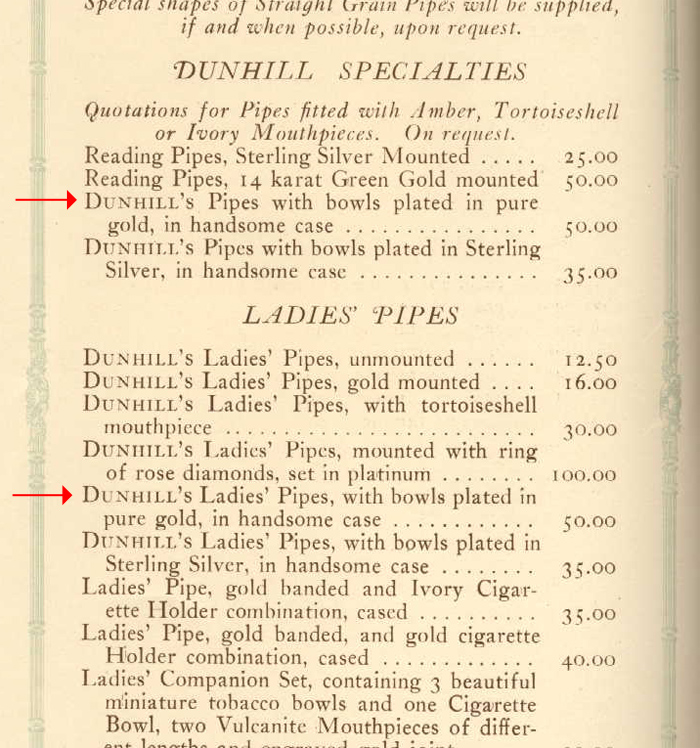Hello boyz. Well, for all the theories out there, of which this forum is only a small part, I too had read quite a few of these comments/opinions/versions of what some believe may be true of the briar discussed.
But, I went and decided to go ahead and buy the pipe anyway. Yeah....I'm the one who actually won the Dunhill 'copper' pipe. Hence, so much for the theory of it being a phantom bidder or a no-sell.
Like yourselves, I had my doubts, not least of which was the errant spelling on the pipe, along with the notion of why Dunhill, even in it's 'mysterious ways' of years past, would even make a metal pipe, AND provided it was even the genuine article, how it would smoke accordingly?
Upon receiving the pipe, some answers I have attained thus far, are the following: It smokes damn well. Apparently, the pipe itself is not metal, but briar coated in it. Why? It seems the presence of metal all around the bowl and shank, unlike in pipes that merely have a metal rim or lid, which would get badly overheated, at least during the first half a bowl full, is NOT the case here.
What occurs with this Dunhill is something else entirely. The heat gets dissipated all around the pipe, bringing it to a gentle lukewarm, somewhat mildly pleasant temperature, whilst the pipe itself actually smokes in an unusually cool fashion -- style and substancewise included.
As far as the misspelling of Dunhill goes? I never actually believed that to be a botched detail in a forgery--merely an incomplete letter print. Why? Think about it, at least for a second. Of all the ways to misspell Dunhill, with either one 'L' or 2 'N's, or even 3 'L''s, like counterfeit goods often do, to use the disclaimer that they never pretended to be the real deal, yet wanted others to believe it to be, exactly that, at least without further inspection. Same said of Chinese counterfeit cell phones, i.e Those which called themselves NOKLA, instead of NOKIA, when a lowercase 'l' can easily pass fro an 'i', at least with some print fonts, certainly from a few feet away -- those are understandable and not even accidental.
With this pipe, how does it even phonetically make sense, to misspell Dunhill with two 'I''s instead of one 'U'? I won't even touch on the fact, as one of you noticed --YES, the nomenclature, number wise, on the pipe, is ALL correct -- it is indeed a 1922, so is the shape number 60, right on Que, for a thick yet smaller than LB billiard, AND the perfectly flush fitting mouthpiece with ivory dot. Not bad for such a sloppy 'forgery', or its forger, who didn't even know how to spell Dunhill, eh?
That would put it smack in the center of the Deco time period, when industry and monumentalism had a strong influence on art -- pipes included. It was also during the roaring 20's, when splendor and pomp, often showing itself in traditional or eccentric ways, was so too often present.
Large sizes or the excess presence of metals are all part of that motif. Do all pipes have it? No. Do more pipes have it during that time period, then say from the time of the great Depression in the 30's? The war of the 40's? The 50's, when pipe styles changed altogether, and Dunhill stopped making patent pieces after '54? Gee, let's think about that one for a while. LOL.
Many of my Dunhill magnums are from that time period, some of the better pieces I got from the Loring collection, including one of his two Tyroleans and an unsmoked Prince of Whales 1926 OD pipe (one of a kind, or so I've been told), are all from that time period. Hence, this pipe, which by the way...get ready for this...a friend of mine who'd worked for a jeweler some years ago, said looks a lot more like ROSE GOLD, not copper, is not out of place -- even despite it's somewhat unusual look.
Many would say, "Then why no gold stamping? Dunhill must have stamped all their gold, right?" Apparently, another supposition gone wrong. I remember, the late Lawrence Kovak, a.k.a Sailorman Jack, showed me one of his prized Dunhills -- an unsmoked little prince, from the 20's, about a group 3 size, by today's standards, had a military mount, no gold stamping. As well, I do remember, he emphatically stressed the mount was rose gold -- hence no oxidation. Pretty much like with this pipe, unsmoked for many, many years, needed no buffing at all -- hardly the characteristic of a base metal, which copper happens to be, and gold is not. And no, this is not because the pipe was handled or buffed -- it simply didn't oxidize.
I still have to get the thing tested, just to make sure, but wouldn't that be something? A rose gold coated 1922 shape 60 Dunhill? Even if it was copper, it would still be a solid find. Hell, who here even heard, let alone see one of these pipes, at least till now? And that's with any metal. Be honest, at least to yourselves, if not others...WHO?
Over the years, I have seen a lot of unusual pieces coming out of Europe, some of which I had the chance to win on ebay. Another piece is a cased amber stem smooth bent Peterson magnum with a 16 ct wide gold band. How many people today have ever even heard of 16 ct gold? Today, ether .585 (14 kt) or .375 (9kt) is the standard for many an Irish or English pipe. Over a hundred years ago, 16 ct was also out there.
Mostly, these pipeces are out of England, though not mutually exclusive to, like this piece, coming out of France. How it wond up in France is anyone's guess. You're talking about over 90 years here, people and things do travel.
Yes, Dunhill had initially used French bowls, refinishing them and calling them Dunhills, but that was in the very beginning, as in midway through their Duke Street days. By 1922, for the smaller pipes, they made their own bowls, for the earliest magnums, they finished the wide bore BBB magnum bowls -- examples of which I so too have -- the wide bore magnums (quite different from my later 20's and 30's magnums) and a BBB magnum.
The point here is not to endorse my collection, merely to illustrate that you need many different sources and actual examples, as opposed to mere theories, to draw fairly sound conclusions. That and actually be open to learning new things. And whilst in theory, most people would say is not a bad approach, based on quite a few reactions here, certainly not all, this appears to not be the case. Good lord people, look at how many derogatory comments there were on a very unusual and valuable piece. What did this pipe ever do to you? LOL
As well, from the very beginning, Dunhill was marketed as an upscale company, pursuing a different course of market appeal, more for well to do folk, not the working classes. It seemed more likely for them to use precious metals like silver and gold, not copper. And whilst some of this had deteriorated, when the company took a downswing in quality, in the late 70's and into the 80's, as was apparent by gold plated bands on their centenary pipes, for example, this was not the same Dunhill of yesteryear, of even the 60's, let alone of the early 20's, of over 60 years before that. A bit more FYI, for those of you still trying to come to grips of this not actually being a copper pipe after all.
On a more personal note, I don't know if Sailor man ever actually smoked his rose gold military mount prince on the dawn of the new millennium, which is what he planned to do, at least back in 1995, when he spoke to me of his plans, at least for the next 5 years. I myself was away for quite a while, and it wasn't until much later that I had gotten the news of Laurence's untimely demise.
Smoke in peace Sailoman, this one's for you.












